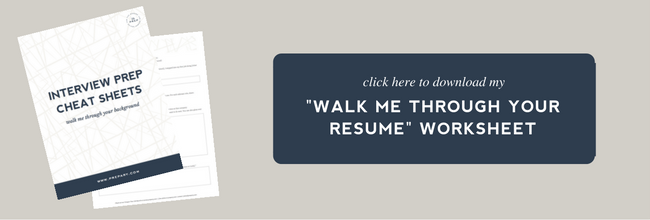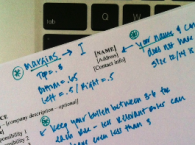It’s been a while since I’ve done a post on a common interview question but it’s time to bring them back!
Today we’re going to cover a super important question that will often be the first thing asked in a job interview.
Walk me through your resume (or your background)
This was actually one of the very first posts I wrote on the blog, but I am ready to give that post a facelift.
Why this question matters
Since this question is often the first thing you’ll be asked, your answer really sets the stage for the remainder of the conversation. Your interviewer genuinely wants to know your story but they’re also getting a sense of your communication skills, enthusiasm, and confidence.
As mentioned in this past blog post, if your interviewer is running straight from another meeting, they might even be using this time to catch themselves up on your background. Yes – they’ve probably already scanned your resume, but who knows when and what they actually remember.
No pressure, right!?
How to answer
Fear not. We’re going walk through exactly how to crush this question in an interview. Here are a few high-level tips before we dive into how to structure your answer:
- Stay professional – personal details are typically not necessary unless they’re part of why you made certain career decisions (and even then sometimes not necessary)
- Keep it between 1 and 3 minutes – and if you really have a lot to share, your absolute max time should be 5 minutes
- Don’t just repeat what’s on your resume – share the “in between the lines” info to help your interviewer really get to know you and explain the “why” behind your career decisions
- Customize your answer to the job – highlight different things about your background and goals based on the job and company (always curate!)
Before we get into the rest, I’d suggest downloading the worksheet above that goes along with this post and then you can start to map out your own answer as you read through.
Part 1: Start at the beginning and/or give a one line overview of your career story
I find that there are 2 effective ways to kick off this answer.
The first option is to start at the very beginning by saying something like, “I’ve always known I wanted to pursue a career in [field] and after studying [major] at [school], I stepped into my first job doing [what you were doing or job title] at [company].”
The second option would be to give a more overarching statement like, “I’ve been working in the [field] field for the past 15 years.”
Either one of these options is a great way to set the stage for the rest of your professional story.
Part 2: Share information on your different work experiences
Regardless of how you begin, your next (and probably most important) step will be to dive into your work history. I recommend starting with your earliest role you held and building up to the present.
If you’ve held many different roles, you might choose to group a few together and not spend time on each one. For example, you might say, “After spending the first 5 years of my career in a few different [functional area] roles, I then joined [company] where I spend X years on the [team name] team.”
If you’ve only held a few roles and those roles are all relevant, you can spend time on each of them.
As far as structure, I suggest covering the below points for each role on your resume.
- Why you joined or any context behind making the move
- Your job title(s) held – if you got promoted, definitely share that
- What your big buckets of responsibility were (don’t assume they already know)
- Something impressive (and again, relevant!) that you accomplished or learned during your time at that company
Remember, spend the most time on the most relevant roles and less time on older jobs or ones that have nothing to do with what you want to do next. It’s your job to curate and not to just brain dump information on your interviewer.
Part 3: Share unique skills or areas of expertise
For most professional backgrounds, I also think it makes sense to share big areas of expertise or skills you’ve picked up throughout your career.
You might say, “throughout these roles, I’ve developed the ability to [insert here] and tons of experience using [any programs or tools].” This a good time to share your strengths and what makes you unique.
If you’ve already included this type of information while speaking about your different roles, you can omit this section.
Part 4: Share “what’s next” – connect your future goals to the role you’re interviewing for
This part is KEY and I promise you that it makes a huge impact.
Most interviewers are curious as to why you’re leaving your current role and what attracted you to the role you applied for, so take this opportunity to share those things proactively.
I think a nice transition sounds something like this:
“While working at [current company] has been a great experience, I’m looking to step into a role/join a company where I can [what you’re looking for that this job can provide].
Always be diplomatic when discussing why you’re leaving your current role but don’t be so vague that it seems like you’re covering something up.
Part 5: Wrap up gracefully
Last but not least, it’s time to wrap up your answer because this answer can easily fall off a cliff.
“…aaannnndddd that’s pretty much it!”
Instead, go with something a little more graceful like, “So that’s what got me interested in this particular role and I’m so excited to have the opportunity to interview for it. Thanks so much for taking the time to chat with me today.”
So much better!
This question is one of the most important ones you’re going to answer in your next job interview so it’s important to take the time to map it out and to practice.
Since you know it’s coming, you have no excuse not to be ready! If you’re prepping for your next interview, don’t forget to grab the free worksheet too.






